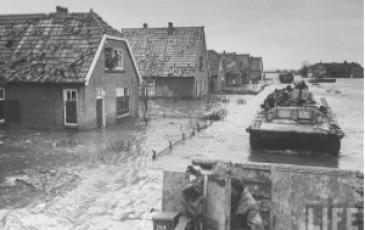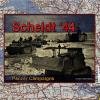1006_01_Breskens_Pocket "Operation Switchback" - PzC 24 Scheldt '44

 0 - 0 - 0
0 - 0 - 0

| Rating: | 0 (0) |
| Games Played: | 0 |
| SM: | 4 |
| Turns: | 97 |
| Type: | Stock |
| First Side: | Allies |
| Second Side: | Axis |
Breskens Pocket, 6 October 1944: Less than a week after mopping up the last German resistance at Calais, Major General Daniel Spry's 3rd Canadian Infantry Division was ordered to reduce the Breskens Pocket. This Canadian offensive, codenamed "Operation Switchback", was a critical component of the larger Allied plan to open the Scheldt River and the port of Antwerp. Though the Canadians enjoyed considerable artillery support and total air superiority, the task at hand would not be easy.
Since late-September, the Breskens pocket had been designated Festung Schelde-Süd, or "Scheldt Fortress-South." Kurt Eberding, commander of the 64. I.D. was named Festungskommandant and tasked with defending the pocket to the last. His reinforced division occupied a blocking line behind the Leopold and Schipdonk Canals and was well-protected by deep trenches and concrete fortifications. Behind this line, the land was crisscrossed by a maze of drainage ditches, dikes, finger lakes, and patches of woods. Furthering the defense, the Germans had flooded large swaths of ground on the eastern and western perimeters.
Unable to employ tanks on this difficult ground, the Canadians would have to rely on infantry and artillery. General Spry's plan called for the 7th Canadian Infantry Brigade to open the offensive with an attack across the Leopold Canal between Sint-Laureins and Eede. Once this sector of the Canal was secured, the 8th CIB would leapfrog the 7th and advance north up the Eede-Draaibrug road, splitting the German force in two. Finally, the 9th CIB would conduct an amphibious landing across the Braakman and position itself in the German rear, sealing the fate of Fortress Scheldt-South. The Canadian infantry set out for the Leopold Canal before dawn on the 6th. The rain-swollen canal would prove to be a formidable obstacle and Eberding's men took their role as fortress defenders more seriously than had the recently vanquished Calais garrison. The Canadians were in for a long fight and Spry's carefully laid plans would have to change...
[Size:Medium]
Design Note: The initial Canadian plan called for the 8th CIB to attack the German center on the Leopold Canal. Owing to the stiff resistance encountered by the 7th CIB, Spry shifted the 8th Brigade to the west to attack across the Isabella Polder. This plan was also scrapped and the 8th CIB ultimately landed at Hoofdplaat, following behind 9th CIB's amphibious attack. The scenario includes strategy options which will allow the Allied Player to choose any one of the three 8th CIB deployments which Spry considered.
This scenario should be played with the "indirect fire" optional rule to enable the Walcheren batteries to fire on Allied targets on the south bank of the Scheldt.
Since late-September, the Breskens pocket had been designated Festung Schelde-Süd, or "Scheldt Fortress-South." Kurt Eberding, commander of the 64. I.D. was named Festungskommandant and tasked with defending the pocket to the last. His reinforced division occupied a blocking line behind the Leopold and Schipdonk Canals and was well-protected by deep trenches and concrete fortifications. Behind this line, the land was crisscrossed by a maze of drainage ditches, dikes, finger lakes, and patches of woods. Furthering the defense, the Germans had flooded large swaths of ground on the eastern and western perimeters.
Unable to employ tanks on this difficult ground, the Canadians would have to rely on infantry and artillery. General Spry's plan called for the 7th Canadian Infantry Brigade to open the offensive with an attack across the Leopold Canal between Sint-Laureins and Eede. Once this sector of the Canal was secured, the 8th CIB would leapfrog the 7th and advance north up the Eede-Draaibrug road, splitting the German force in two. Finally, the 9th CIB would conduct an amphibious landing across the Braakman and position itself in the German rear, sealing the fate of Fortress Scheldt-South. The Canadian infantry set out for the Leopold Canal before dawn on the 6th. The rain-swollen canal would prove to be a formidable obstacle and Eberding's men took their role as fortress defenders more seriously than had the recently vanquished Calais garrison. The Canadians were in for a long fight and Spry's carefully laid plans would have to change...
[Size:Medium]
Design Note: The initial Canadian plan called for the 8th CIB to attack the German center on the Leopold Canal. Owing to the stiff resistance encountered by the 7th CIB, Spry shifted the 8th Brigade to the west to attack across the Isabella Polder. This plan was also scrapped and the 8th CIB ultimately landed at Hoofdplaat, following behind 9th CIB's amphibious attack. The scenario includes strategy options which will allow the Allied Player to choose any one of the three 8th CIB deployments which Spry considered.
This scenario should be played with the "indirect fire" optional rule to enable the Walcheren batteries to fire on Allied targets on the south bank of the Scheldt.





















